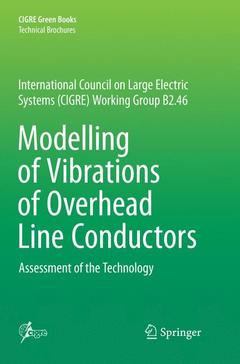Description
Modelling of Vibrations of Overhead Line Conductors, 1st ed. 2018
Assessment of the Technology
Technical Brochures Series
Coordinator: Diana Giorgio
Language: English
Publication date: 01-2019
Support: Print on demand
Publication date: 03-2018
Support: Print on demand
Description
/li>Contents
/li>Biography
/li>Comment
/li>
This brochure offers numerical models of wind-induced aeolian vibrations and sub-span oscillations of the conductors. It highlights what can be expected from numerical models regarding conductor vibrations.
- Assessment of the aeolian vibration condition of particular lines, with conductors whose mechanical properties are poorly defined, or with special terrain conditions, may require field measurements;
- Analytical methods based on the EBP and shaker-based technology can provide a useful tool to design damping systems for the protection of single conductors against aeolian vibrations
It fosters the design, construction, and operation of overhead lines, including the mechanical and electrical design of line components, validation tests, study of in service performance, the assessment of the state of line components and elements, maintenance, as well as the refurbishment and life extension as well as upgrading and uprating of overhead lines.
The output of the deliberations and actions would enable quality, capability, availability, maintainability, and the ability to raise capital and insurance to be realized.
Giorgio Diana received his Degree in Mechanical Engineering from Politecnico di Milano in 1961. Since 1971 he is a full professor of Applied Mechanics and in December 2010 he has been appointed Professor Emeritus of Politecnico di Milano. His actual main research fields are: bridges dynamics, railway vehicle - infrastructure dynamic interaction and aero-elasticity problems.
He is presently chairing various scientific committees such as the Steering Committee of the Joint Research Centre (JRC) on Transportation, the Italcertifer Consortium Certification Committee, the Working Group on Super-long Span Bridge Aerodynamics of IABSE (International Association of Bridge Engineers) and the Working Group B2-58 (Vibration Modelling of High Temperature Low Sag conductors - Self-damping characterization) of CIGRE (Conférence Internationale des Grandes Réseaux Electriques à Haute Tension).
The results of the research and activities are reported in about 300 papers published mainly in international peer reviewed journals as well as in keynote lectures held at several international conferences.
As a result of his achievements Prof. Diana received in 2009 the Robert H.




